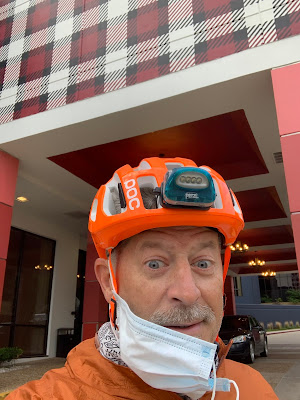Arkansaw High Country Race Day 1 Fayetteville to Pilot Rock / Opening Salvo
Day 1 Fayetteville to an informal campsite near Pilot
Rock Mountain. 121 miles
At 7 a.m. in brisk 50-degree air, I turned on my GPS Spot tracker that would show up as a blue MM icon on the Trackleaders website and rolled out of town on my Chumba Terlingua titanium all-road bike. The course gradually, then steeply climbed up to White Rock Mountain over a four-hour stretch and then bombed down to the Mulberry River, eventually popping out on Highway 23 near Cass.
Here was the first place I planned poorly. I knew that the general store at Oark closed at 4 pm, but I assumed the route would take me right past the store at Turner Bend, where I would top off on food and water. When I got on Highway 23 and realized the store at Turner Bend was behind me, I put my head down and chugged to make it to Oark by 3 pm. I walked in sweaty and out of breath and the guy working the cash register shouted, “How ‘bout a burger?” I said, “I´d like three!” I sat down and ate one burger meal for lunch and put the other two wrapped burgers in a musette that I slung over my shoulder. One of the big mistakes I’ve made in the past on races like this was to not take enough food with me when I get a chance to resupply. When we bikepack we typically pack our bags to the gills and have no room for that extra meal, condemning ourselves to run low on calories[2]. My solution this year was to carry a small extra bag to carry the food I couldn’t eat right at the moment. Those second and third burgers made supper that night and breakfast the next morning, not the most appetizing thing ever, but I needed the calories to replenish the long first day and fuel me to Russellville and beyond the next day. Even though most days I was riding 12 – 15 hours, far fewer than the big guns who do this race in about five days, I was still burning up to 8 - 10,000 calories per day. When you sit down to eat at a restaurant and really throw down on as much food as you can, you generally only eat about 2,000 calories at a meal, and you won’t be passing restaurants five times a day on the High Country Race. For me, this race seemed to be a constant fight to take onboard as many calories as possible, knowing I’d usually come up short.
I found an informal campsite on public land along the trail
near Pilot Rock, rolled out my bivvy and air mattress[3],
got out of my sweaty cycling gear and into dry clothes, and ate my dinner
burger in the gathering darkness.
Despite the slight miscalculation at Turner Bend, the first
day had gone according to plan.
[1] In
my June 2020 ITT I spend several hours per day over multiple days riding in
temps of over 100 degrees and high humidity, which really broke me down mentally and physically
[2] Of
course, one could bring freeze-dried camp meals, a stove and fuel, but I opted
not to go that route in order to save weight and space.
[3] I
brought a down jacket and down pants to act as defacto “sleeping bag” lining
within my thin Gore-Tex bivvy sack. To run with a little lighter load, I did
not bring a tent or a tarp.





Comments
Post a Comment